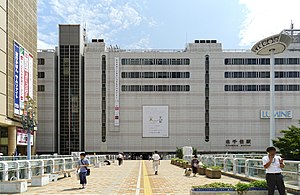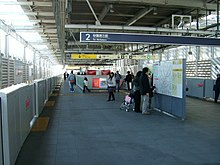Kita-Senju train station
| Kita Senju ( 北 千 住 ) | |
|---|---|
|
West side of the station (August 2017)
|
|
| Data | |
| Location in the network | Crossing station |
| Platform tracks | 10 (train) + 4 (subway) |
| abbreviation | JJ-05 / TS09 |
| opening | December 25, 1896 |
| location | |
| City / municipality | Adachi |
| prefecture | Tokyo |
| Country | Japan |
| Coordinates | 35 ° 44 '59 " N , 139 ° 48' 18" E |
| Height ( SO ) | 0 m TP |
| Railway lines | |
|
Shutoken Shintoshi Tetsudō |
|
| List of train stations in Japan | |
The Kita-Senju train station ( Japanese 北 千 住 駅 , Kita-Senju-eki ) is a train station on the Japanese island of Honshū . It is located in the district of Adachi in Tokyo and is an important transportation hub, where three rail lines and two subway -lines intersect.
links
Kita-Senju is a crossing station that is used by four different railway companies. The Jōban Line of JR East leads from Shinagawa and Ueno along the Pacific coast to Sendai . Depending on the time of day, four to seven express and express trains run every hour. Local traffic on the Jōban line to and from Abiko has short trains of a few minutes; the trains are in Kita-Senju usually the Tokyo Metro Chiyoda Line of Tōkyō Metro by bound and continue until Yoyogi-Uehara .
The Isesaki line of the Tōbu Tetsudō (also called Tokyo-Skytree-Line in the urban area ) connects Asakusa with Tōbu-dōbutsu-kōen , where the trunk line branches into several branches. There is a brisk traffic with short train headways and a large number of express and local trains, the latter often being tied through to the Hibiya line of Tōkyō Metro. The Tsukuba Express provides a connection between Akihabara and Tsukuba . All express and local trains stop here, which also results in a dense sequence of trains (individual trains turn in Moriya ).
On the western forecourt is an important bus station , which is served by 15 lines of the Toei Bus , Tōbu Bus Central and Shin-Nihon Sightseeing Bus companies, as well as several night bus lines and an airport shuttle. Two Keisei Bus lines stop in front of the eastern entrance .
investment
The station is on the border of Senju (in the west) and Senju-asahichō (in the east), both of which are part of Tokyo's Adachi district . The facility is oriented from south to north and has a total of 14 tracks for passenger traffic, seven of which are at ground level, four are underground and three are in an elevated position. These are distributed over four parts of the station, which are connected by extensive pedestrian passages. Tokyo Denki University is at the east entrance and the Lumine and Senju Mildix shopping centers in front of the west entrance .
The Chiyoda line and the connected local trains of the Jōban line stop under the western station forecourt . The double-track subway station operated by Tōkyō Metro has two side platforms . This is followed by the oldest section of the station of JR East , which is reserved for the express trains of the Jōban line. It has three tracks on a side and a central platform . The station building spans over it in the form of a riding station . The Tsukuba Express train station is attached to this . The two tracks are in an elevated position on two side platforms, which are equipped with platform screen doors. This part is the newest; Until it was built, there were tracks for freight traffic here. In the far east, Tōbu Tetsudō and Tōkyō Metro share the fourth and largest section of the station. The three-storey and completely covered facility comprises seven tracks. Trains on the Isesaki line stop at two central platforms with four tracks at ground level. The first floor is a distribution level with numerous shops and restaurants. On the second floor, the subways of the Hibiya line stop at a side and a middle platform with a total of three tracks.
After Shinjuku , Shibuya and Ikebukuro , Kita-Senju is the fourth busiest train station in the Tokyo districts . In the 2018 fiscal year, an average of 220,903 JR East passengers used the station, plus 50,643 at Shutoken Shintoshi Tetsudō. In the 2017 fiscal year, the average number of passengers on the Tōbu Tetsudō was 225,784 people daily, while 149,510 people frequented the Hibiya Line and 148,392 people the Chiyoda Line.
Tracks
JR East (at ground level)
| 1 • 2 | ■ Jōban line (express trains northwards) | Matsudo • Kashiwa • Narita • Toride • Tsuchiura |
| 2 • 3 | ■ Jōban line (express trains southwards) | Nippori • Ueno • Tokyo • Shinagawa |
Tōbu Tetsudō / Tōkyō Metro Chiyoda Line (underground)
| 1 |
|
Ōtemachi • Yoyogi-Uehara • Isehara • Karakida |
| 2 |
■ Jōban Line (local trains) |
Ayase • Abiko |
Tōbu Tetsudō / Tōkyō Metro Hibiya Line (at ground level and in an elevated position)
| 1 • 2 | ■ Isesaki Line (northward) |
Tōbu Nikkō • Tatebayashi • Akagi • Kuzū • Isesaki • Tōbu-Utsunomiya • Ōmiya Kasukabe • Tōbu-dōbutsu-kōen • Kuki • Minami-Kurihashi |
| 3 • 4 | ■ Isesaki Line (southward) |
Hikifune • Tokyo Skytree • Asakusa Hanzōmon Line : Shibuya • Den'entoshi Line : Chūō-Rinkan |
| 5 | ■ Isesaki Line (northward) | Kita-Koshigaya • Tokyo Skytree • Kita-Kasukabe • Tōbu-dōbutsu-kōen |
| 6 • 7 |
|
Ueno • Ginza • Roppongi • Naka-Meguro |
Shutoken Shintoshi Tetsudō (in an elevated position)
| 1 |
|
Moriya • Tsukuba |
| 2 |
|
Akihabara |
history
The private railway company Nippon Tetsudō opened the station on December 25, 1896, as part of the line between today's Tabata freight yard and Tsuchiura , which connected the capital Tokyo with the important Jōban coal district near Hitachi . Almost three years later, Kita-Senju developed into a suburban railway junction when the Tōbu Tetsudō opened the first section of the Isesaki line from here to Kuki on August 27, 1899 . Nearly three more years passed until the opening of the line between Kita-Senju and Azumabashi (now Tokyo Skytree ) on April 1, 1902. Following the entry into force of the Railway Nationalization Act , the railway took office (today's Ministry of Railways ) on 1 November 1906, the Nippon Railway while the Tōbu Tetsudō remained independent until today.
Compared to the city-side end stations Ueno and Asakusa , the passenger frequency in Kita-Senju was significantly lower for half a century, which began to change in the early 1960s. The Teito Kōsokudo Kōtsū Eidan ( Eidan for short, known as the Tōkyō Metro since privatization in 2004 ) extended the Hibiya Line on May 31, 1962 from Minami-Senju to this point, including a connection to the Isesaki Line. On December 20, 1969, the Eidan extended the Chiyoda line from Ōtemachi to Kita-Senju, with which the station was now connected to two subway lines. Finally, on April 20, 1971, the Chiyoda line was extended to Ayase .
Passenger frequencies rose rapidly and soon matched the values of stations on the Yamanote Line . For this reason, the Kita-Senja station had to be expanded in several stages in order to reduce congestion, especially during rush hour. The shopping center integrated into the station opened its doors on March 28, 1985. As part of the privatization of the state railway, the station became the property of the new company JR East on April 1, 1987 . In 1992, the expansion of the station section with the Isesaki line and the Hibiya line to a three-storey facility began; after five years, work was completed in March 1997. On August 24, 2005, the platforms for the Tsukuba Express from Akihabara to Tsukuba went into operation.
Adjacent train stations
|
←
|
Lines |
→
|
||
|---|---|---|---|---|
| Minami-Senju |
|
Matsudo | ||
| Ushida |
Tōbu Tetsudō |
Kosuge | ||
| Minami-Senju |
Shutoken Shintoshi Tetsudō |
Aoi | ||
| Machiya |
Tōkyō Metro |
Ayase | ||
| Minami-Senju |
Tōkyō Metro |
Kosuge | ||
Web links
- JR East Station Information (Japanese)
- Station information of Tōbu Tetsudō (Japanese)
- Tokyo Metro Station Information (Japanese)
- Station information Tsukuba Express (Japanese)
Individual evidence
- ↑ a b JR 時刻表 2019 年 3 月 号 (JR timetable March 2019). Kōtsū shinbunsha, Tokyo 2019.
- ↑ 各 駅 の 乗車 人員. JR East , 2018, accessed November 24, 2019 (Japanese).
- ↑ Tokyo Statistical Yearbook. Tokyo Metropolitan Government , 2017, accessed November 24, 2019 (Japanese).
- ↑ 経 済 発 展 の 基礎 を 築 く. In: 常 磐 線 100 年 特集, Ibaraki Shimbun, December 25, 1996.
- ↑ 運輸 開業 免 許 状 下 付. In: Official Gazette. National Parliamentary Library , August 31, 1899, accessed November 24, 2019 (Japanese).
- ↑ 運輸 開始. In: Official Gazette. National Library of Parliament , May 4, 1902, accessed November 24, 2019 (Japanese).
- ^ Tokyo. urbanrail.net, 2019, accessed on November 24, 2019 .
- ↑ Tōkyō Metro (Ed.): 帝都 高速度 交通 営 団 史 . Tokyo December 2004, p. 617 .




